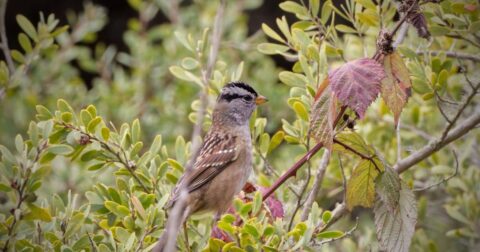Feature
The Meat Industry’s Hidden Link to Wildfires
Climate•6 min read
Reported
Researchers call this effect "weather whiplash" but say sanctuaries and sustainable land strategies could help.


Words by John Platt, The Revelator
When dead birds fall from the sky, you know something is wrong. But finding out exactly what killed them isn’t as easy.
Scientists had plenty of theories when migratory sparrows, flycatchers, blackbirds, swallows, warblers and other birds in the southwestern United States turned up dead or dying in August and September of 2020. Some suggested it could have been smoke from wildfires. Others said it could have been a cold snap. Some experts thought it was lack of food, as evidenced by the birds’ emaciated, dehydrated bodies.
No matter what the cause, the effect was devastating on the people who found the bodies. “I collected over a dozen in just a two-mile stretch in front of my house,” biologist Martha Desmond told The Guardian that September. “To see this many individuals and species dying is a national tragedy.”
Now we may know why those thousands of birds died. According to a paper published in the journal Sustainable Horizons, the deaths were caused by “compound climate extremes” — multiple factors and events that pounded the birds over and over again until they expired.
It started in August 2020, when smoke and heat from Western wildfires forced migratory birds to flee their traditional feeding grounds before they could bulk up for the winter. They moved inland at first, landing in areas where food and water were naturally scarce. That would have been okay under normal, well-fed conditions, but then came the second punch. A four-day cold snap and snowstorm struck the northern Rockies and pushed the already weakened birds to move yet again. Not yet recovered from their first emergency journey, they turned their beaks southward, where their energy stores finally gave out.
The researchers call this “weather whiplash” — or more scientifically, an “ecological cascade” — and warn that future double or triple whammies could pose a threat to migratory species here in the United States and around the world. It could even cause extinctions, they write.
But they also provide a roadmap that could help lessen the impact. First, the authors call on the scientific community to further study the threats of environmental stress on bird health, so we better understand when we need to intervene. They also express the need for sustainable land strategies that could provide alternatives to existing trees, so birds have more places to nest, roost and feed. Finally, they recommend preparing sanctuaries to help injured animals recover in these potentially affected ecosystems and implementing reintroductions to boost populations of species suffering from all these compound effects.
In a world where climate extremes get more dangerous every year, and where people also suffer from weather whiplash, adaptations like this will become increasingly necessary — unless we want to see more flocks falling from the sky.